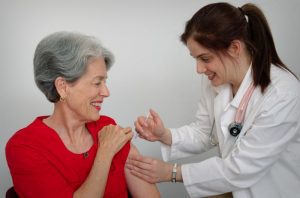 Hepatitis A is a contagious liver disease. It results from infection with the hepatitis A virus (HAV). HAV can range in severity from an illness lasting a few weeks to a severe illness lasting months. It can be found in the feces (stool) of infected people and their feces can contaminate surfaces, objects, food, or water. People get sick by swallowing the contaminated food or water or by putting their hands in their mouths after touching contaminated surfaces or objects. The virus can also spread from person to person through sexual activities and sharing contaminated needles.
Hepatitis A is a contagious liver disease. It results from infection with the hepatitis A virus (HAV). HAV can range in severity from an illness lasting a few weeks to a severe illness lasting months. It can be found in the feces (stool) of infected people and their feces can contaminate surfaces, objects, food, or water. People get sick by swallowing the contaminated food or water or by putting their hands in their mouths after touching contaminated surfaces or objects. The virus can also spread from person to person through sexual activities and sharing contaminated needles.
Click on the tabs below to learn more about hepatitis A and how to prevent it through vaccination.
Frequently Asked Questions About Hepatitis A
What is hepatitis A?
Hepatitis means inflammation of the liver. When the inflammation is caused by infection with the hepatitis A virus (HAV), the disease is called hepatitis A. Hepatitis A ranges in severity from a mild disease lasting several weeks to a severe disease lasting several months. About 3,000 cases of hepatitis A are estimated to occur in the United States each year; a smaller number of cases are actually reported to public health each year because many infected people have no symptoms or mild symptoms and do not go to see a doctor.
Who gets hepatitis A?
Anyone who has not been infected with HAV previously or has not been vaccinated against hepatitis A can become infected and ill from HAV. People at greater risk of getting hepatitis A include those who travel to or live in countries where hepatitis A is common, those who have sexual contact with someone who has hepatitis A, men who have sex with other men, people who use recreational drugs, people who have clotting disorders, and household members or caregivers of a person infected with hepatitis A.
How is hepatitis A spread?
HAV can be found in the feces (stool) of infected people and their feces can contaminate surfaces, objects, food, or water. People get sick by swallowing the contaminated food or water or by putting their hands in their mouths after touching contaminated surfaces or objects. The virus can also spread from person to person through sexual activities and sharing contaminated needles.
What are the symptoms of hepatitis A?
Not everyone who is infected will have symptoms. If symptoms develop, they can include tiredness, poor appetite, fever, or nausea. Some people might also have vomiting or abdominal pain, clay-colored stool, or dark urine. Jaundice (a yellowing of the skin and the whites of the eyes) might appear. The disease is rarely fatal and most people recover in a couple of months. Infants and young children tend to have very mild symptoms and are less likely to develop jaundice than are older children and adults.
How soon after exposure do symptoms appear?
Symptoms usually appear within 4 weeks after exposure, with a range of 15–50 days.
How is hepatitis A diagnosed?
Signs and symptoms are the same for all types of acute viral hepatitis, including hepatitis A. As a result, acute hepatitis A must be diagnosed by a specific laboratory test on a sample of blood.
What is the treatment for hepatitis A?
Unvaccinated people who have been recently exposed to HAV can be given the hepatitis A vaccine or a shot of immune globulin within two weeks of the exposure to prevent severe illness. Otherwise, there are no special medicines that can be used to treat a person once the symptoms appear. Generally, doctors recommend rest, good nutrition, fluids, and treatment of symptoms to help a person recover from hepatitis A. A small number of people might need to be hospitalized. It might take a few months before people with hepatitis A begin to feel better.
How can hepatitis A be prevented?
The best way to prevent hepatitis A is by getting vaccinated. The hepatitis A vaccine is recommended for the following groups: all children at age 1 year, travelers to countries where hepatitis A is common, family and caregivers of adoptees from countries where hepatitis A is common, men who have sex with men, users of recreational drugs (whether injected or not), people working with non-human primates, people with chronic or long-term liver disease (including hepatitis B or hepatitis C), people with clotting-factor disorders, and people with direct contact with others who have hepatitis A.
Hand hygiene is important to prevent the spread of HAV. Always wash hands carefully after using the toilet, changing diapers, engaging in sexual activity that involves anal contact, and before eating or preparing food. Avoid eating raw shellfish taken from potentially contaminated waters. People with hepatitis A should not handle foods during the contagious period.
To clean contaminated surfaces, use approximately ¼ cup of 5.25% bleach in one gallon of water or use cleaning solutions containing quaternary ammonium and/or hydrogen chloride (found in many toilet cleaners).
What should I do if I have been exposed to hepatitis A?
Close contacts of an infected person and other people who have been exposed to HAV (e.g., by a food handler or contaminated food) should call their doctor or local health department to see if they should get a shot of vaccine or immune globulin to reduce their chance of becoming ill.
How long can an infected person carry the hepatitis A virus?
The contagious period begins about two weeks before symptoms appear. Most people are probably no longer contagious after the first week of jaundice. People, especially children younger than 6 years of age, can spread the virus without having any symptoms.
Should an infected person be excluded from work or school?
Yes. People with symptoms should be excluded, especially children who attend day care and people who work in locations where there is an increased risk of spreading the virus, including restaurant, day care, and healthcare workers.
How can I get more information about hepatitis A?
- If you have concerns about hepatitis A, contact your healthcare provider.
- Call your local health department. A directory of local health departments is located at https://www.vdh.virginia.gov/local-health-districts/.
- Visit the Centers for Disease Control and Prevention (CDC) website at https://www.cdc.gov/hepatitis/hav/. For specific information about international travel and hepatitis A, visit the CDC website at https://wwwnc.cdc.gov/travel/yellowbook/2018/infectious-diseases-related-to-travel/hepatitis-a.
All images courtesy of the Centers for Disease Control.
Hepatitis A Vaccine
The hepatitis A vaccine is safe and effective and is the best way to prevent infection and subsequent illness due to the hepatitis A virus (HAV). The vaccine is available in two single antigen formulations and in a combination hepatitis A/hepatitis B vaccine.
Among recipients of a single-antigen vaccine, 95% of adults and 97% of children and adolescents will be protected after the first dose and nearly all vaccine recipients will be protected after two doses. In adults receiving a combination hepatitis A/hepatitis B vaccine, nearly 94% will be protected after the first dose and nearly all will be protected after completing the three dose series.
Hepatitis A Prevention in Virginia
In Virginia, local health departments, in conjunction with community partners, are working to prevent hepatitis A from spreading throughout the Commonwealth. Beginning in January 2019, a statewide hepatitis A vaccination campaign will focus on increasing the number of Virginians properly immunized for hepatitis A.
The vaccination campaign will focus specifically on individuals who are members of high risk groups such as those who are/have recently been incarcerated, persons who are experiencing homelessness, injection and non-injection drug users, and men who have sex with men (MSM). Although the campaign’s focus is on those who at higher risk for hepatitis A infection, any Virginian who desires hepatitis A vaccine should receive the vaccine.
Where to find hepatitis A vaccine
Hepatitis A vaccine is available at a variety of locations across Virginia. Many doctor's offices and pharmacies carry the vaccine and it is also available at local health departments across the state. Click here to find the closest health department.
All images courtesy of the Centers for Disease Control.
Resources for Healthcare Providers 
General Information about Hepatitis A
- Hepatitis A infection [CDC]
- Hepatitis A vaccination [CDC]
- Hepatitis A fact sheet [VDH]
- Viral hepatitis [VDH]
Educational Resources for Providers
CDC Updates on Nationwide Hepatitis A Outbreak
Virginia Vaccines for Children/Adults Program
- Virginia Vaccines for Adults (VVFA) Program
- VVFA Enrollment for Providers Interested in Providing Vaccinations to Un/Underinsured Patients
- Virginia Vaccines for Children (VVFC) Program

